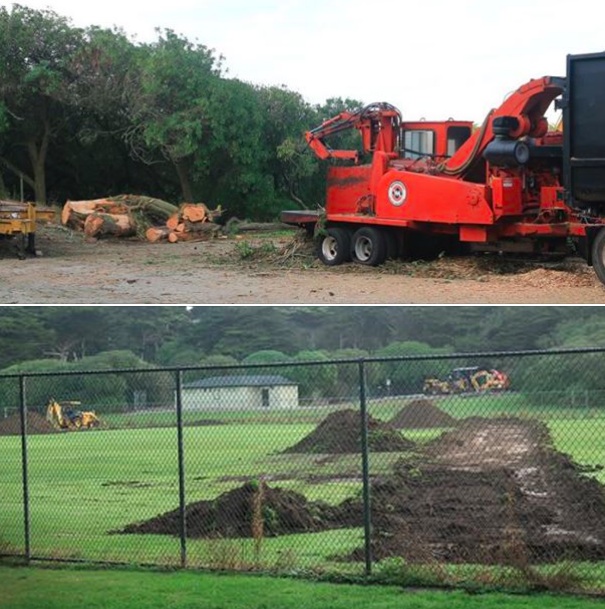
By Tim Redmond
NOVEMBER 7, 2014 – We could fight forever over the safety of the new fields they’re putting in at Golden Gate Park. I am not a scientist, and (as is always the case) the industry that makes the artificial turf (out of chopped up old tires) has experts who say it’s safe.
But since the city, before the election is even certified, has started cutting down trees and moving in bulldozers in a mad rush to put down artificial turf, I thought I would put in a little perspective.
I offer this not as an expert in toxicology or chemical engineering (I took Organic Chemistry in college, but that was a loooong time ago) but as someone who has been writing about environmental issues for 30 years. Even wrote a book about environmental history, and travelled through the deep South talking to people about toxics, cancer clusters, and exposure levels.
And I also say this as someone who has watched this particular Department of Parks and Recreation, under this particular leadership, rush into doing what a few rich donors want. The artificial turf is funded by the City Fields Foundation, which is a project of the children of GAP mogul Don Fisher.
The Fisher kids (and will pay for) artificial turf. So grass fields all over the city are being converted to turf.
It’s an increasing problem in our society: Instead of government taxing the rich and making decisions in the public interest, government is letting the rich decide what’s they’re willing to pay for, and that’s driving policy.
But back to the turf.
Here is what we as a society have learned from the post-War Chemical Revolution:
- There is no “safe” exposure to hazardous chemicals.
- This shit is everywhere.
- Thus, you can’t easily prove than any specific health problem came from any single source or single exposure to anything.
But that doesn’t mean you ignore the problem.
There are lots of reasons people get cancer. People who never work in or live near chemical plants get cancer; people who live in remote mountains get cancer. But more of the people who are exposed to cancer-causing chemicals get cancer.
That doesn’t mean any one individual who works around any one chemical will get any specific disease. But if you expose 5,000 people to a carcinogen, more of them will get cancer than 5,000 people who weren’t exposed.
Which ones? Nobody can predict.
We can’t avoid all chemical exposure, not and live normal lives in a big city. You can’t walk down the street without breathing diesel exhaust. You can’t get in a new car, or go into a house with new carpets, or sit on a new couch, without breathing in some nasty – potentially cancer-causing — stuff.
Also: People are different. Some people have greater sensitivity to some kinds of chemicals. I’m not a bit bothered by second-hand cigarette smoke, but I get terrible headaches around pressure-treated wood. My brother’s a carpenter who works with PT wood all the time, and it doesn’t bother him a bit. (Of course, that doesn’t mean the poison in the wood won’t get to him at some point; people change, too. I used to use spray paint all the time, and now it makes me sick.)
Can we all live in chemical-free bubbles? Of course not (we’d probably make the bubbles out of plastic anyway). But with all that said, you can be smart about it, and limit excessive exposure to stuff that we all agree is bad for you. And you can do your best to protect your kids.
See, it’s all about odds. The more you ingest certain toxic chemicals, the greater the risk you will have adverse health effects. And there’s no question that some of the chemicals in chopped up tires are bad for you.
NBC, in a story that has gotten wide circulation, found some indications of increased health problems in young soccer goalies who play on fields with crumb rubber. But the story also said that there’s no proven connection between exposure to crumb rubber and cancer. The EPA says “more testing needs to be done.”
Right now, nobody’s doing that testing, not at the federal level. We’re just taking the assurances of the turf companies that this stuff won’t hurt you.
We do know that the rubber contains toxic chemicals, including benzene and lead. When the fields get hot, some of that stuff evaporates into the air. Are the exposure levels high enough to be “unsafe?” Maybe not, by current standards.
Again, some perspective: For more than half a century, this country has leapt ahead with chemical technologies that everyone said were safe at the time but turned out to have serious health consequences. I can’t think of a single time when we decided NOT to use some chemical compound for fear it would hurt us and it turned out that we were wrong and the stuff was perfectly safe.
Sports facilities are different than, say, city streets. People dive into the turf, get it in their ears and eyes and noses and mouths. Stuff gets ingested that might be harmless to the touch. And when athletes are running around a lot, they inhale and process a lot more air.
My friend Susan Gerhard interviewed a prominent environmental lawyer in Washington, D.C. His name is Chris Nidel – and he has a masters in Chemical Engineering and is also a soccer player who just started playing goalie. Here’s what he told her:
“I had noticed, or my wife had noticed, that since I had been playing goalie, I would come home with a whole lot more tire crumb than I used to. When you come home from playing a game, you take off your shoes and they’re full of the tire crumb. You take off your next layer and it’s full of the tire crumb. And you take off the next layer, and it’s full of the tire crumb. All the way til you take a shower.
I started looking up what tires are made of. I quickly came to isobutadiene or polybutadiene and styrene rubber as the primary components for making tires. Then I went to my database that I use — one of the first places I look for the connection between chemicals and cancer relationships or any disease relationship — and looked up butadiene. The database I use is broken into ‘good,’ ‘ok’ and ‘poor’ relationships. So if a chemical is associated with a disease, it’s listed in one of those categories. For butadiene, lymphoma was listed in one of the top strength-of-association categories.
In my little scratch-the-surface look — the kind of thing I do when I get a call and someone says ‘I live next to this landfill, and …. they have x, y, z in our water, and oh, by the way four kids on our street have cancer,’ I would look and see ‘does this make sense, is it plausible?’ It looked to me like it makes sense. You’re making tires out of butadiene, you’ve presumably got a good amount of butadiene exposure. And it’s plausibly related to the outcomes that we’re seeing. It’s plausibly related to blood cancers, leukemia and lymphoma. And, to add to that, goalies appear to be more exposed than the average player and they seem to be the ones that are getting sick first and are more likely to get sick.
Again: Numbers games. Anyone who lives in a city is exposed to exhaust, bits of used rubber, and (in the past) lead and asbestos from cars. People who work at toll booths get more exposed to those things. They’re more likely to have problems.
I can’t argue that the artificial fields are “unsafe.” But I think we all agree that they potentially expose people to increased levels of some chemicals that have been linked to some health problems. (I’m sure nobody would recommend, for example, that you eat large amount of chopped-up tires.)
Toxcologists are fond of saying “the dose is the poison.” A couple of Tylenol pills won’t hurt you a bit, but it says right on the label not to take an overdose, which can harm your liver.
With a lot of these chemicals, we don’t know what dose is harmful. We do know that no exposure to any toxic chemical is 100 percent “safe.” Expose enough people to enough levels of benzene and some will get cancer. What’s “enough?” How many people? Honestly, seriously, nobody can say for sure.
Would we rather have no cars or buses at all and eliminate the health risks that come from inhaling exhaust? Maybe not. But over the years, we’ve tried to reduce the risk (for example, by eliminating lead in gasoline.)
Proponents of the turf say: Would we rather have grass fields that are a mess, full of gopher holes, unplayable in wet weather, poorly maintained and not good for soccer? A better question: Would we rather have grass fields that are well maintained and designed, and pay for them by taxing the Fisher brothers and the rest of the billionaires in this city? We don’t ask that.
Maybe ten or 20 years from now, we’ll look back and say: Why did we let little kids play soccer on chopped up tires? Why didn’t we make sure it was safe before we did it? If that happens, it will fall entirely within the pattern of environmental messes that we’ve made this century.
Maybe not.
But whatever: The Recreation and Parks Department is doing what the Fisher kids will pay to do, and nothing else seems to matter.




